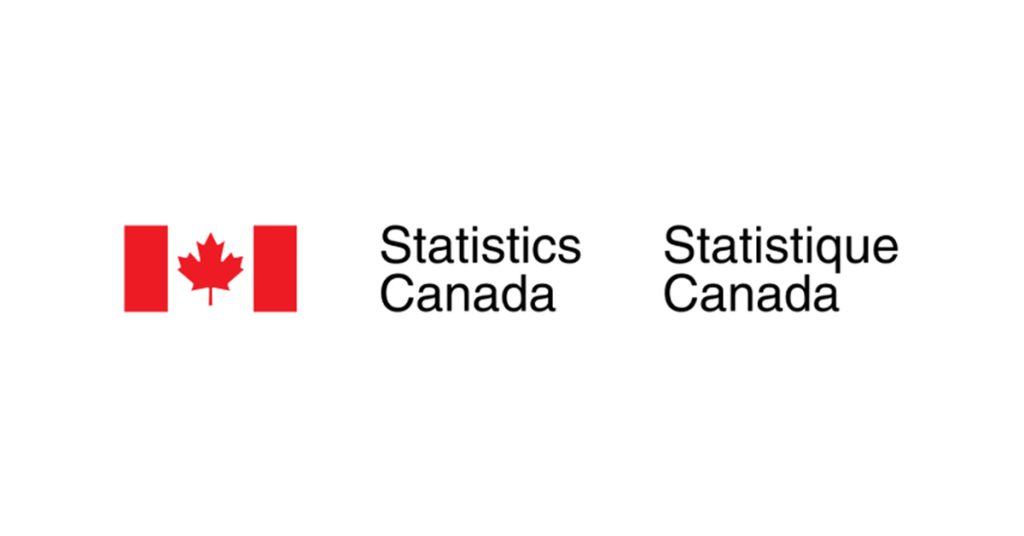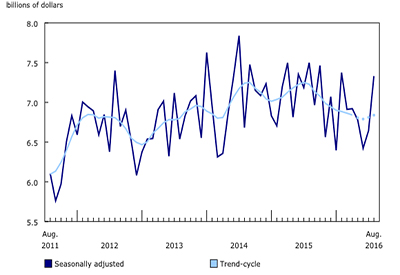Labour Force Survey, November 2024

December 13, 2024
Labour employment increased by 51,000 (+0.2%) in November and the employment rate held steady at 60.6%. The unemployment rate rose 0.3 percentage points to 6.8%, as more people looked for work.
In November, employment rose among core-aged (25 to 54 years old) men (+45,000; +0.6%), while it fell among women aged 55 to 64 years old (-20,000; -1.3%).
Employment rose in the month in wholesale and retail trade (+39,000; +1.3%), construction (+18,000; +1.2%), professional, scientific and technical services (+17,000; +0.9%), educational services (+15,000; +1.0%), and accommodation and food services (+15,000; +1.3%). It declined in manufacturing (-29,000; -1.6%), transportation and warehousing (-19,000; -1.7%) and natural resources (-6,300; -1.8%).
Employment increased in Alberta (+24,000; +1.0%), Quebec (+22,000; +0.5%), Manitoba (+6,600; +0.9%) and Prince Edward Island (+2,700; +2.9%) in November, while it was little changed in the other provinces.
Total hours worked were little changed in November (-0.2%) but were up 1.9% compared with 12 months earlier.
Average hourly wages among employees increased by 4.1% (+$1.40 to $35.68) on a year-over-year basis in November, following growth of 4.9% in October (not seasonally adjusted).
Employment rises in November, driven by full-time work
Employment rose by 51,000 (+0.2%) in November, following little change in October. Employment gains were concentrated in full-time work (+54,000; +0.3%).
After falling for six consecutive months from May to October, the employment rate—the proportion of the population aged 15 and older who are employed—held steady at 60.6% in November, as employment growth in the month kept pace with growth in the population aged 15 and older in the Labour Force Survey (LFS) (+0.2%). On a year-over-year basis, the employment rate was down 1.2 percentage points.
Chart 1
Employment rate holds steady in November following six consecutive monthly declines

Infographic 1
Employment rate by age group

Public sector employment rose by 45,000 (+1.0%) in November, and accounted for the majority of the overall employment gain in the month. The number of employees in the private sector and the number of self-employed people were both little changed in November.
Compared with 12 months earlier, the number of employees in the public sector grew by 127,000 (+2.9%) in November. The increase was driven by the public-sector component of health care and social assistance (+81,000) and educational services (+48,000) (not seasonally adjusted). Over the same period, private sector employment rose at a slower pace (+1.3%; +173,000).
Employment increases among core-aged men while it declines among women aged 55 to 64
Employment increased by 45,000 (+0.6%) among core-aged (25 to 54 years old) men in November, pushing the employment rate for men in this age group up 0.3 percentage points to 86.5%. This increase in the employment rate partly offset a cumulative decline of 0.5 percentage points in September and October.
Employment among women aged 55 to 64 years fell by 20,000 (-1.3%) in November. The employment rate for women in this age group in November (58.6%) was down 0.7 percentage points from October, and down 1.9 percentage points from a recent peak of 60.5% in May 2024.
There was little change in employment among the other major age groups in November.
Unemployment rate rises to 6.8%
The unemployment rate increased 0.3 percentage points to 6.8% in November, the highest rate since January 2017 (excluding the years 2020 and 2021, during the COVID-19 pandemic). The unemployment rate has trended up since April 2023, rising 1.7 percentage points over the period.
The number of unemployed people—those looking for work or on temporary layoff—increased by 87,000 (+6.1%) in November, bringing the total number of unemployed persons to 1.5 million. On a year-over-year basis, the number of unemployed people was up by 276,000 (+22.2%).
The unemployed population includes people who lost or left their previous job, as well as people who are new entrants to the labour force. In November, nearly half (46.3%, or 663,000 people) of unemployed people had not worked in the last year or had never worked, up from 39.5% in November 2023 (not seasonally adjusted). In comparison, the share of unemployed people who had lost their job prior to being unemployed (38.8%) and the share who had voluntarily left their previous job (14.9%) were both down from a year earlier.
Chart 2
Unemployment rate rises in November

The proportion of long-term unemployed people has increased along with the unemployment rate. Among unemployed persons, 21.7% had been continuously unemployed for 27 weeks or more in November, up 5.9 percentage points from a year earlier.
The labour force participation rate—that is, the proportion of the population aged 15 and older who were employed or looking for work—increased by 0.3 percentage points to 65.1% in November, offsetting a cumulative decline of 0.3 percentage points in September and October. On a year-over-year basis, the participation rate was down by 0.5 percentage points.
Youth unemployment rate up in November
The youth unemployment rate rose 1.1 percentage points to 13.9% in November, partially offsetting a cumulative decline of 1.7 percentage points in September and October. In November, the unemployment rate increased for both young men (+1.4 percentage points) and young women (+0.9 percentage points) aged 15 to 24 years. On a year-over-year basis, the youth unemployment rate was up 2.3 percentage points, the largest increase among the major age groups.
The unemployment rate of core-aged women rose 0.3 percentage points to 5.8% in November, marking the third consecutive monthly increase. The unemployment rate for women in this age group was up 1.2 percentage points compared with 12 months earlier.
Infographic 2
Unemployment rate by age group

In comparison, the unemployment rate for core-aged men was unchanged at 5.7% in November, and was up 0.6 percentage points on a year-over-year basis. The unemployment rate for core-aged men had been on a general upward trend from May 2023 to August 2024, and has since varied little.
Among people aged 55 and older, the unemployment rate increased by 0.4 percentage points to 5.3% in November. On a year-over-year basis, the unemployment rate was up 1.3 percentage points to 6.0% for men in this age group and little changed at 4.5% for women.
Employment gains across several industries
There were more people employed in wholesale and retail trade in November (+39,000; +1.3%), the second increase in three months. The recent gains have offset a net decline in the industry from January to July. On a year-over-year basis, employment in wholesale and retail trade was little changed in November.
In construction, employment rose by 18,000 (+1.2%) in November, following five consecutive months of little change. Despite the increase in the month, employment in the industry in November was essentially unchanged from a year earlier.
Employment rose in professional, scientific and technical services (+17,000; +0.9%) in November, the second increase in three months. On a year-over-year basis, employment in the industry was up by 72,000 (+3.8%).
Chart 3
Employment increases led by wholesale and retail trade in November

There were fewer people working in manufacturing in November (-29,000; -1.6%), following eight consecutive months of little change. The decline in November was concentrated in Ontario, where manufacturing employment fell by 20,000 (-2.5%).
Employment in transportation and warehousing declined by 19,000 (-1.7%) and total hours worked fell 3.5% in November. The decline in hours worked was associated with several labour disputes that occurred during the LFS reference week of November 10 to November 16, namely, the lockout of workers at the Vancouver and Montréal ports, as well as the Canada Post strike.
More people employed in Alberta, Quebec, Manitoba, and Prince Edward Island in November
Employment increases in Alberta (+24,000; +1.0%) and Quebec (+22,000; +0.5%) accounted for most of the overall national employment increase (+51,000; +0.2%) in November.
In Alberta, the employment gain in November was the third in four months, and pushed the employment rate in the province up 0.4 percentage points to 64.1%. The unemployment rate in Alberta was little changed at 7.5% in November.
In Quebec, the employment rate rose 0.2 percentage points to 60.9% in November, marking the first monthly increase in the employment rate in the province since September 2023. The unemployment rate in Quebec was 5.9% in November, little changed from the previous month.
Map 1
Unemployment rate by province and territory, November 2024

There was little overall employment change in Ontario in November and the unemployment rate in the province increased 0.8 percentage points to 7.6%—the highest since May 2014 (excluding the years 2020 and 2021). This increase was driven by more Ontarians in the labour force and searching for work. The labour force participation rate—the proportion of the population aged 15 and older in Ontario who were employed or looking for work—rose 0.4 percentage points in November, offsetting a similar-sized decline in October.
Employment rose in Manitoba (+6,600; +0.9%) and Prince Edward Island (+2,700; +2.9%) in November. In Prince Edward Island, the employment gain was associated with a 2.0 percentage point decline in the unemployment rate, which fell to 8.0% in November.
Unemployment rate up in most of the large census metropolitan areas
Among Canada’s 20 largest census metropolitan areas (CMAs), Windsor posted the highest unemployment rate at 8.7% in November, followed by Edmonton (8.3%), Toronto (8.1%), and Calgary (7.9%) (three-month moving averages). Unemployment rates were lowest in the Victoria (3.7%) and Québec (4.5%) CMAs.
Infographic 3
Unemployment rate rises in most of the large census metropolitan areas

On a year-over-year basis, the unemployment rate rose in most of the 20 largest CMAs, led by Calgary (+2.0 percentage points), Edmonton (+1.9 percentage points) and Québec (+1.8 percentage points).
In the spotlight: 3 in 10 Canadians aged 25 to 54 completed training outside the regular education system in the previous 12 months
The emergence of new technologies and the ongoing transformation of the economy can lead to important changes in the demand for different types of skills within the labour market. In addition to the education system, different types of training can help address skills gaps. Several factors can drive participation in training, including investment made by employers, costs, and employee motivation and availability.
In November, 29.2% of persons aged 25 to 54 had taken training outside the regular education system in the previous 12 months (such as courses, seminars, conferences, or private lessons), down 0.8 percentage points compared with November 2022, the last time the question was asked in the LFS.
Among core-aged Canadians who took training in the previous 12 months, the most common type was job-specific training (73.9%), suggesting that employers play a critical role in driving training participation. Other types of training people were likely to take included personal development training (17.8%) and occupational health and safety training (15.4%). Despite ongoing technological change, the proportion who had taken general computer-related training in the last 12 months was little changed at 8.8% in November 2024.
In November 2024, core-aged persons who did not take training in the previous 12 months were most likely to indicate this was in part because there was no need for them to do so (69.5%), similar to the proportion in November 2022. At the same time, compared with November 2022, higher proportions indicated they did not take training because they were too busy (+3.6 percentage points to 16.7%) or because the training was too expensive (+2.5 percentage points to 9.6%).
In the spotlight: a greater share of hybrid workers work half of their hours or more at locations other than home
In November 2024, 12.5% of employed Canadians indicated that they usually worked exclusively at home and 11.5% had a hybrid arrangement—that is, they usually worked some hours at home, and some hours at locations other than home (population aged 15 to 69, not seasonally adjusted). Both proportions were little changed from November 2023.
Among hybrid workers, 55.8% worked at least half of their hours at locations other than home during the LFS November reference week, up 4.2 percentage points from the same month in 2023 (workers aged 15 to 69 who were not absent from work). The increase partly reflects a shift towards more time spent on-site among hybrid workers in public administration, where the proportion of hybrid workers who worked at least half of their hours at locations other than home rose 19.9 percentage points to 61.5% over the period.
In comparison, the proportion of hybrid workers who worked half of their hours or more on-site was little changed in professional, scientific, and technical services (44.1%) and finance, insurance, real estate, rental and leasing (39.9%)—two industries with relatively high rates of hybrid work.











